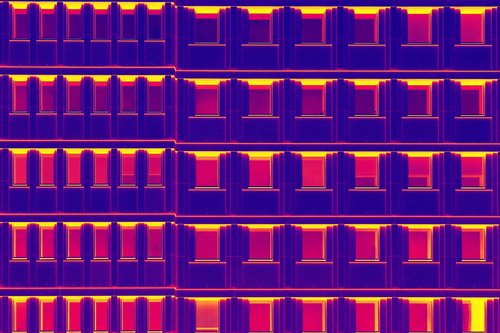Coating Developed for Hot Window Thermal Imaging
WEDNESDAY, DECEMBER 18, 2024
Scientists from Rice University have created a coating that can filter out the thermal hot noise of a window, making it possible to capture clear images of objects through them. The research findings were recently reported in the journal Communications Engineering.
“Say you want to use thermal imaging to monitor chemical reactions in a high-temperature reactor chamber,” said Gururaj Naik, an associate professor of electrical and computer engineering at Rice and corresponding author on the study. “The problem you’d be facing is that the thermal radiation emitted by the window itself overwhelms the camera, obscuring the view of objects on the other side.”
While one solution could involve coating the window in a material that suppresses thermal light emission, it would also render the window opaque. The new coating reportedly relies on an engineered asymmetry to filter out the thermal noise, doubling the contrast of thermal imaging compared to conventional methods.
According to the university, the core of the technology uses nanoscale resonators, which function like miniature tuning forks to trap and enhance electromagnetic waves within specific frequencies. The resonators are made from silicon and then organized in an array that allows control over how the window emits and transmits thermal radiation.
“The intriguing question for us was whether it would be possible to suppress the window’s thermal emission toward the camera while maintaining good transmission from the side of the object to be visualized,” Naik said.
“Information theory dictates a ‘no’ for an answer in any passive system. However, there is a loophole—in actuality, the camera operates in a finite bandwidth. We took advantage of this loophole and created a coating that suppresses thermal emission from the window toward the camera in a broad band but only diminishes transmission from the imaged object in a narrow band.”

 |
| fhm / Getty Images |
|
Scientists from Rice University have created a coating that can filter out the thermal hot noise of a window, making it possible to capture clear images of objects through them. |
This was reportedly achieved by designing a metamaterial comprising two layers of different types of resonators separated by a spacer layer. The design consequently allows the coating to suppress thermal emissions directed toward the camera, while remaining transparent enough to capture thermal radiation from objects behind the window.
“Our solution to the problem takes inspiration from quantum mechanics and non-Hermitian optics,” said Ciril Samuel Prasad, a Rice doctoral engineering alum and first author on the study.
Results found a “revolutionary” asymmetric metawindow capable of clear thermal imaging at temperatures as high as 873 degrees Kelvin (approximately 600 degrees Celsius or 1,112 degrees Fahrenheit).
One application would be in the chemical processing industry to monitor reactions inside high-temperature chambers. This approach could also revolutionize hyperspectral thermal imaging by addressing the long-standing “Narcissus effect,” where thermal emissions from the camera itself interfere with imaging.
Additionally, researchers say they envision applications in energy conservation, radiative cooling and even defense systems.
“This is a disruptive innovation,” the researchers noted. “We’ve not only solved a long-standing problem but opened new doors for imaging in extreme conditions. The use of metasurfaces and resonators as design tools will likely transform many fields beyond thermal imaging from energy harvesting to advanced sensing technologies.”
Henry Everitt, senior scientist at the United States Army Research Laboratory and adjunct faculty at Rice, is also an author on the study. The research was supported by the United States Army Research Office.
Tagged categories: Coatings; Coatings technology; Coatings Technology; Colleges and Universities; Research and development; Temperature; Thermal emittance; Thermal imaging; Windows



